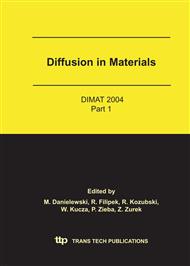p.3
p.7
p.19
p.30
p.38
p.50
p.62
p.74
Sedimentation of Substitutional Solute Atoms in Condensed Matter: New Type of Diffusion
Abstract:
Ultra-strong gravitational field (Mega-gravity field) causes the sedimentation of even atoms (diffusion), and is expected to create a nonequilibrium crystal-chemical state in multi-component condensed matter. However, the materials science research under mega-gravity field has now remained as an unexploited field, while the sedimentation of molecules or polymer had been used in biochemistory. We presented a self-consistent diffusion equation for sedimentation of atoms in condensed matter. Next, we developed an ultracentrifuge apparatus to generate strong acceleration field of over 1 million (1x106) g at temperature range up to 〜300 °C, and, recently, succeeded in realization of the sedimentation of substitutional solute atoms in some alloys of Bi-Sb, In-Pb, Bi-Pb systems, etc. The diffusion coefficients in sedimentation on Bi-Sb alloy were estimated to be much greater than those at normal conditions by a factor of >20. It is suggested that the sedimentation of substitutional atoms in solids or liquids can be explained in a new type of diffusion, where the diffusion mechanism for substitutional solute atoms was yet unknown. In this article, the recent progress in the investigation of sedimentation of atoms under mega-gravity field is reviewed, and the diffusion mechanism is discussed. The application of the mega-gravity field is also discussed.
Info:
Periodical:
Pages:
30-37
Citation:
Online since:
April 2005
Authors:
Price:
Сopyright:
© 2005 Trans Tech Publications Ltd. All Rights Reserved
Share:
Citation:


